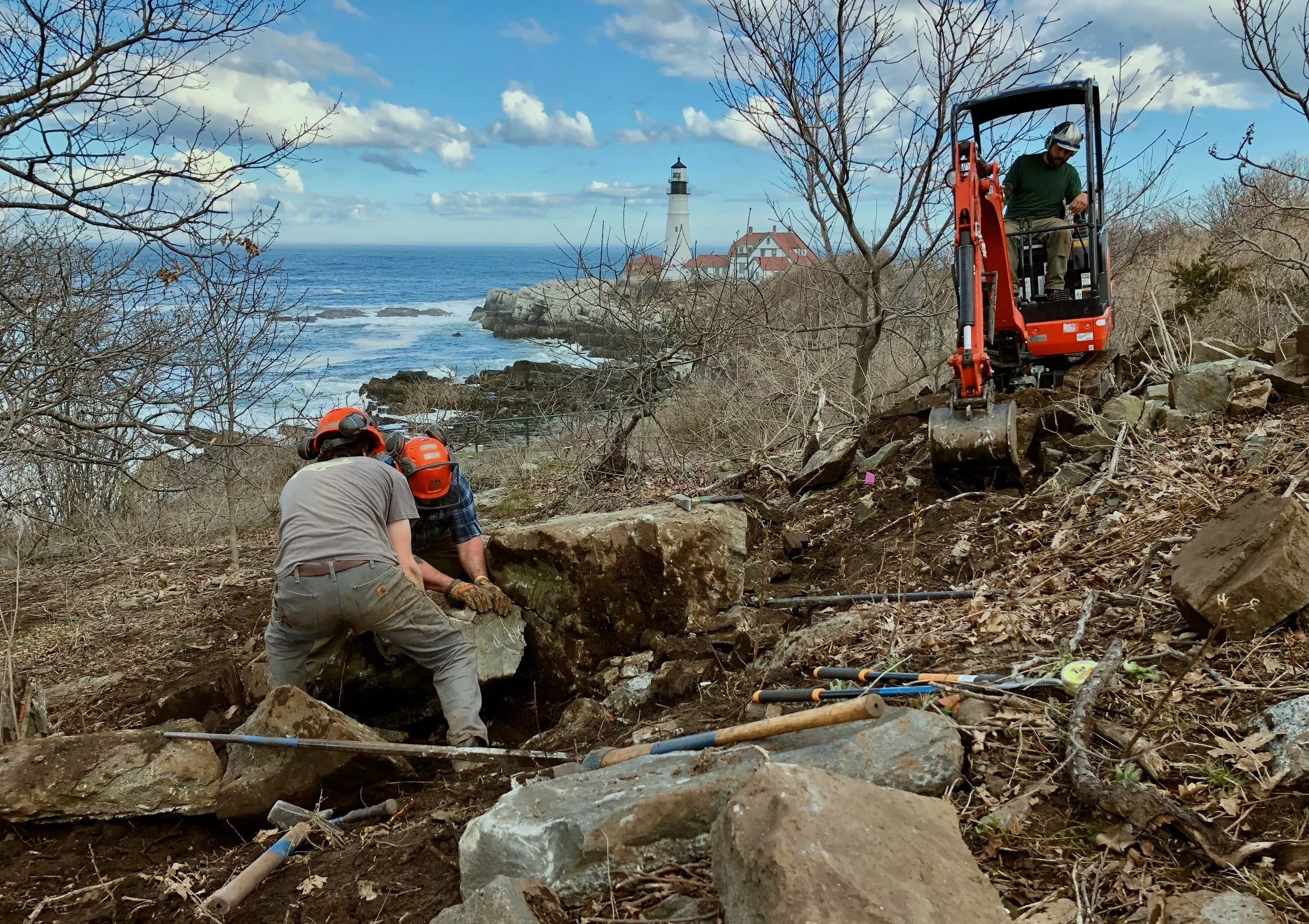
Best Practices
for Safety in
Trail Construction
Photo: OBP Trailworks
Trail construction is inherently dynamic and often performed in remote, rugged environments making safety not just a priority, but a foundational element of professional trail work.
PTBA has drafted these basic best practices aimed at creating a culture of safety, accountability, and continuous improvement across trail construction projects. They reflect both industry standards and field-proven strategies that address the wide range of risks faced by trail crews.
Overall, these best practices are closely aligned with general construction industry standards, and in some areas, such as mental health, long-term risk, and environmental readiness, they go even further. Informed by insights from PTBA’s end-of-year member survey on safety, they represent an evolution of construction safety principles, applied to the unique conditions of the trailbuilding environment.
Below best practices are broken into 9 categories. The specific trainings that are listed are currently US-centric, but will be bolstered with additional information through work with the global PTBA membership.
1. Personal Protective Equipment (PPE) & Gear
Require and enforce the use of relevant basic PPE: hard hats, proper footwear, gloves, high-visibility clothing, safety glasses, hearing protection, and long pants.
Provide stipends or reimbursements for more highly protective gear (e.g., steel-toe boots, eye protection), where necessary.
Ensure specialized PPE is available for high-risk equipment such as chainsaws, brush cutters, rock breakers, blasting, etc.
Maintain PPE in good working condition and replace it regularly.
PPE must always be worn correctly and completely on-site.
Encourage crew leaders to verify PPE compliance during regular site reviews.
2. Equipment & Worksite Safety
Maintain all equipment regularly and inspect it before use.
Remove or replace equipment known to expose unnecessary hazards (i.e. dull tools, degraded chainsaw blades, loose handles).
Ensure all tools and vehicles are in good working order; maintain maintenance logs.
Conduct jobsite-specific safety checks, including terrain hazards, wildlife/vegetation threats, and emerging weather risks.
Use traffic control and signage when working near roads, trailheads, or high-use recreation areas.
Provide signage or safety tape to warn of an active construction site
Assign clear roles for equipment and safety oversight to ensure accountability.
Maintain and enforce a drug-free work site.
3. Training & Education
Deliver regular, ongoing training: tailgate meetings, safety debriefs, and monthly safety committee reviews.
Include scenario-based training and field simulations, especially for high-risk tasks or emergencies.
Create a culture of active learning: pair new hires with seasoned trailbuilders, host in-field demonstrations, and utilize company safety manuals and job-specific materials to guide trailbuilding operations.
Emphasize situational/crew/machine awareness and proper communication, terrain hazards, and ergonomic movement.
Educate workers on hydration, nutrition, fatigue management, and mental health.
Provide opportunities for training such as OSHA 10-hour training and certifications in CPR, Wilderness First Aid, and chainsaw operation
4. Planning, Communication & Culture
Conduct Job Hazard Assessments (JHAs) before and during all projects.
Share clear safety plans with all staff, subcontractors, and volunteers.
Facilitate open communication and a “speak-up” culture where employees feel safe reporting risks, errors, and near misses—without retribution.
Encourage cross-functional collaboration—involving designers, crew leads, risk officers, and land managers during planning phases.
Hold regular site-specific safety briefings and risk review meetings.
Use digital communication tools and checklists for consistency and transparency.
5. Hiring, Experience & Onboarding
Hire only skilled professionals for high-risk tasks and machinery operation.
Verify experience in terrain-specific conditions.
Provide onboarding that includes safety walkthroughs, tool handling demos, equipment protocols, and job hazard assessment familiarization.
Use mentorship to support less experienced staff in real-time.
Embed organizational safety values during the onboarding process to build a strong safety culture.
6. Safety Programs, Protocols & Certifications
Develop and enforce a robust Safety Plan compliant with OSHA, land agency protocols, and/or other relevant regulations.
Develop and train on a fire prevention and response plan that pertains to diesel, gas, and hydraulic fluid fires, as well as tool- or lightning-instigated sparks.
Implement a “Stop Work Authority” policy so any worker can halt unsafe practices without penalty.
Maintain certifications like ISO 45001, WorkSafe BC SAFE + COR, and relevant regional standards, where required.
Conduct quarterly reviews of safety procedures to adapt to changing tools, techniques, and environments.
Understand and integrate land use permits, liability insurance, and legal preparedness into safety planning.
Create contingency plans for large-scale disruptions like wildfires, floods, or disease outbreaks.
7. Physical and Mental Health
Adapt work hours to suit seasonal conditions (e.g., early start during hot weather).
Promote wellness through proper hydration/nutrition and rest reminders.
Foster physical readiness by encouraging workers to stay fit.
Foster realistic workload expectations and provide seasonal breaks or paid time off to prevent burnout.
Foster an inclusive and supportive workplace that respects individual needs and identities.
Offer support for mental health through clear communication, de-stressing practices, and team check-ins.
8. Continuous Improvement & Accountability
Use digital tools (like the Zero app, Google Forms, or scheduled Zoom calls) to keep safety communication active and accessible.
Document incidents and near-misses using structured root-cause analysis to inform prevention strategies.
Assign on-site safety officers or leads to ensure regular checks and accountability.
Conduct safety audits, encourage peer feedback, and evolve protocols based on real job site experiences and lessons learned.
9. Long-Term Operations & Risk Management
Recognize that risk doesn’t end when the trail is built - post-construction operations and maintenance plans and risk audits are essential.
Develop a maintenance and inspection schedule and record keeping structure specific to the trail/system for erosion control, vegetation management, signage, and user impact.
Plan for the full life cycle of the trail, including future community use, access, and growth.
Involve stakeholders (land managers, volunteers, public safety officials) in long-term trail operations and maintenance and risk management strategies.
